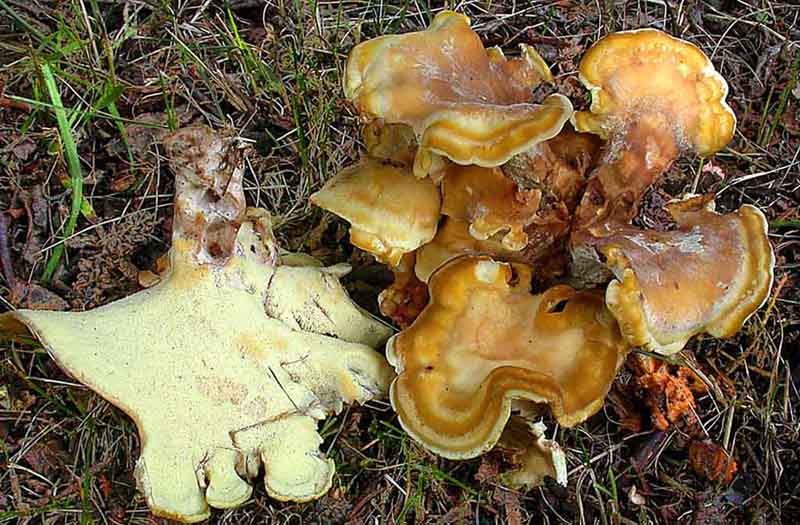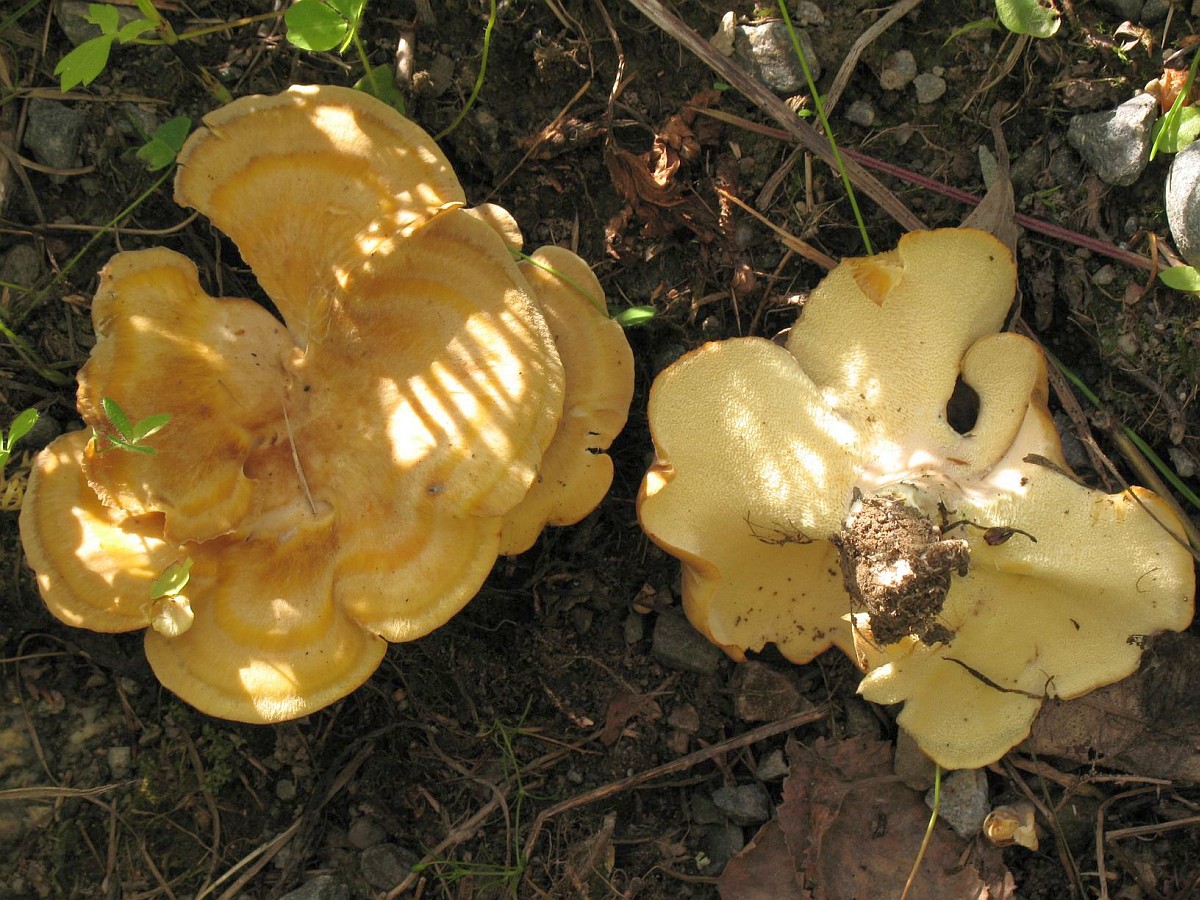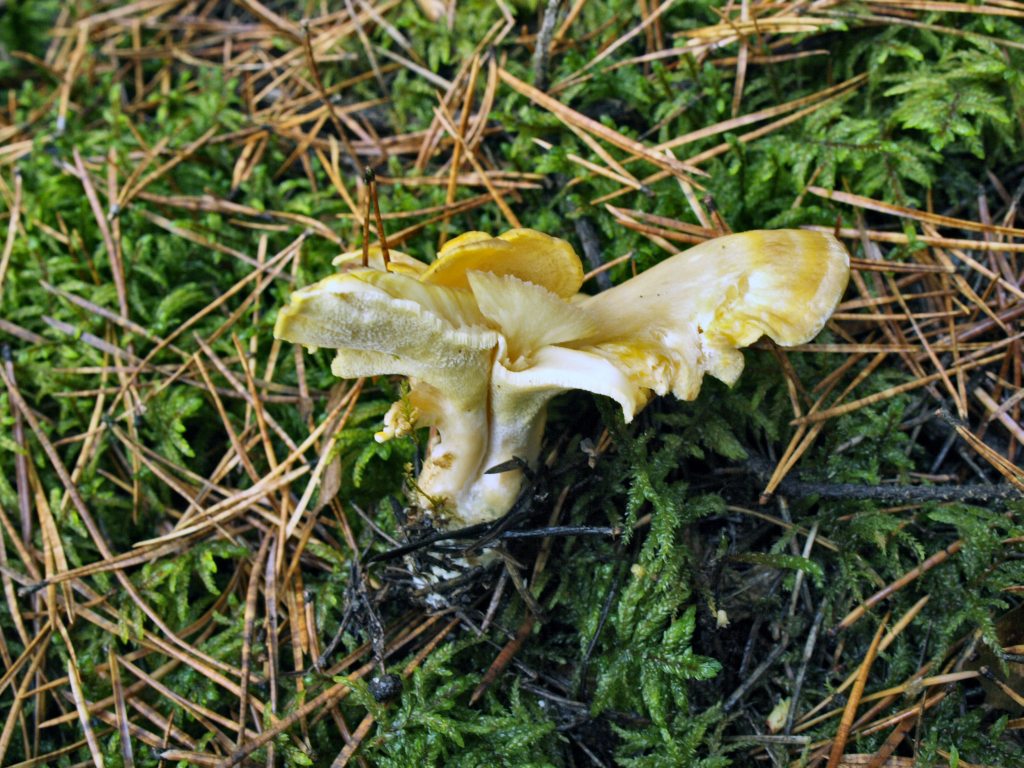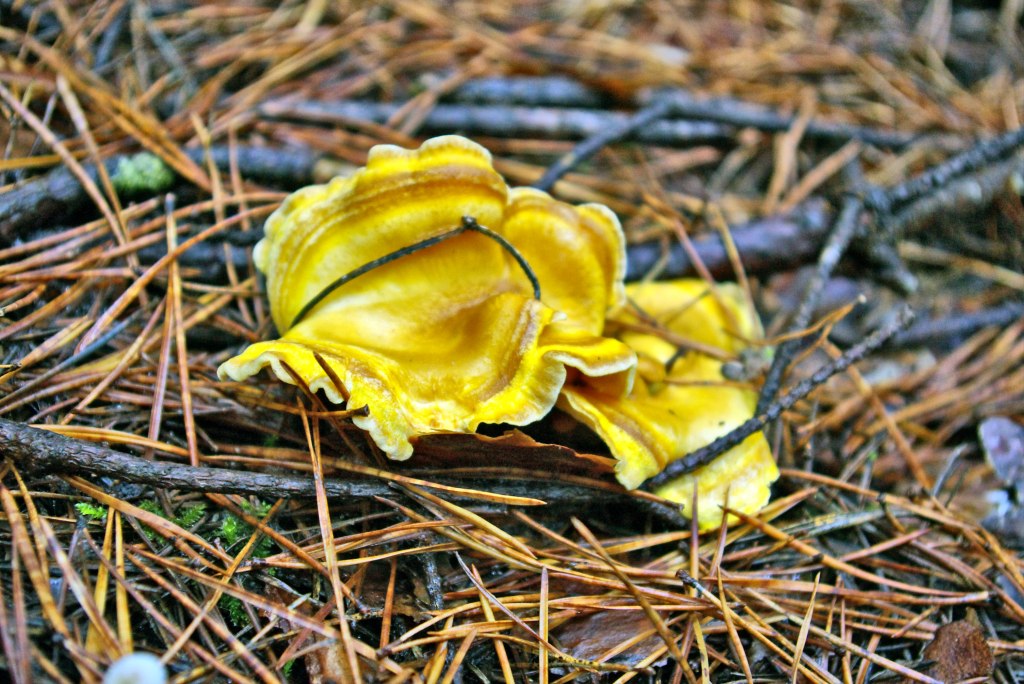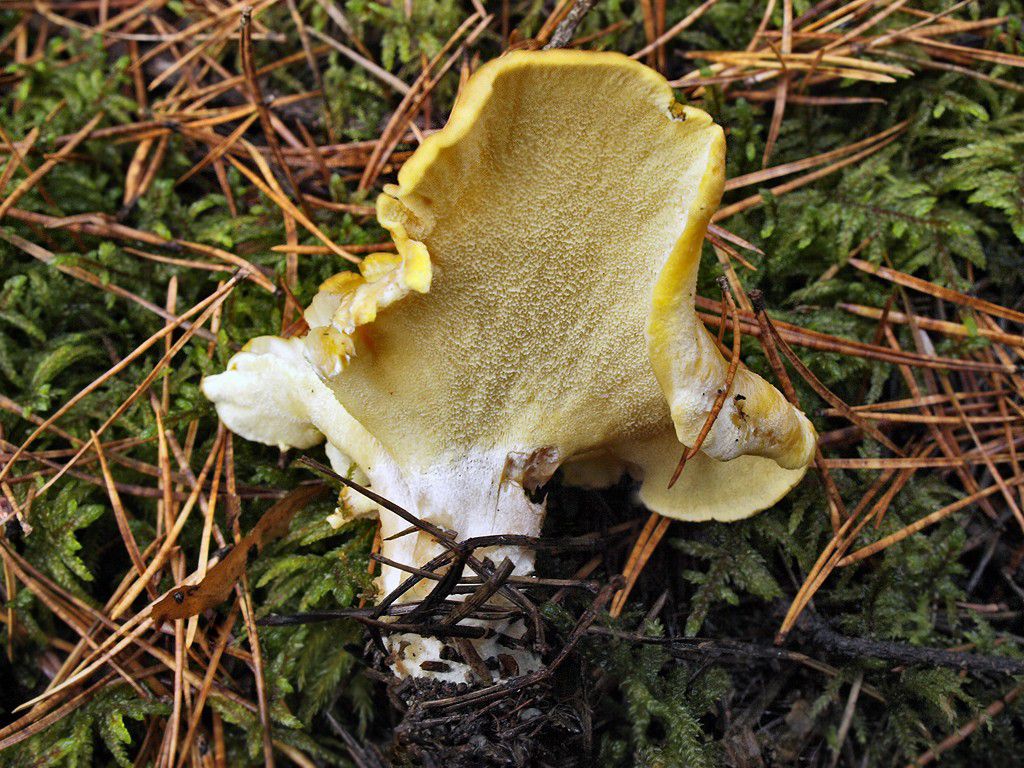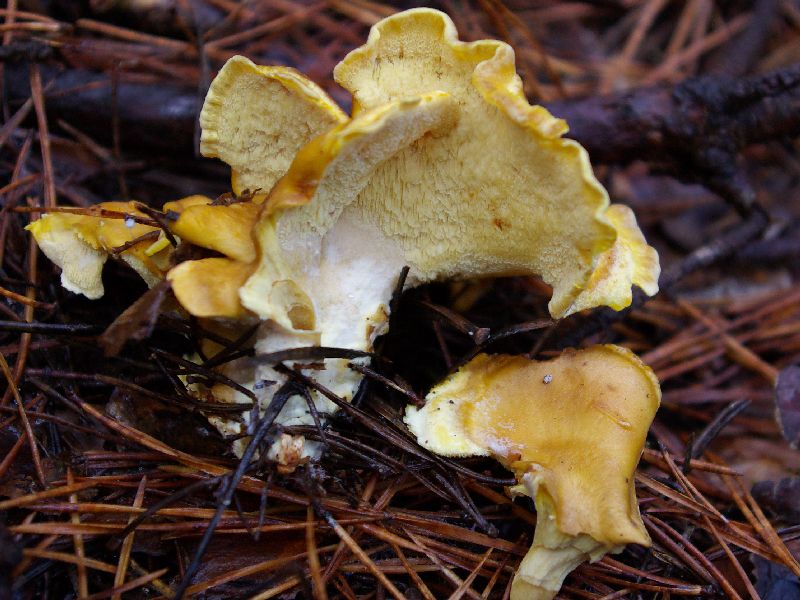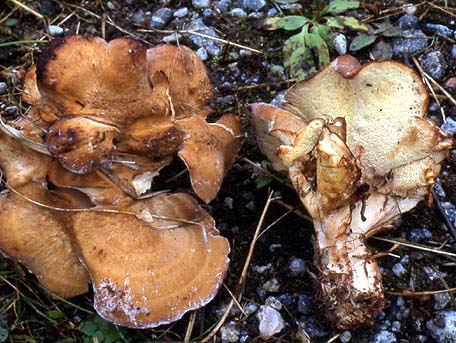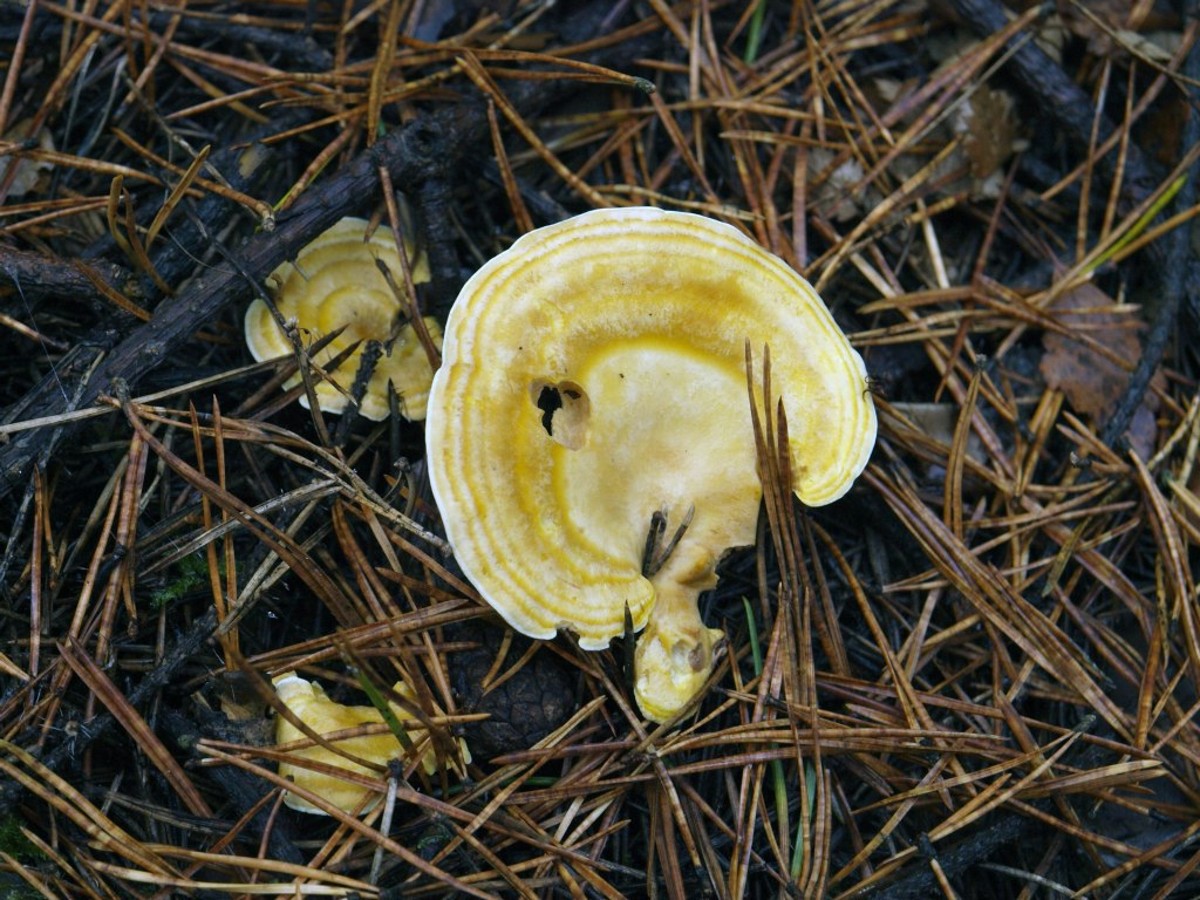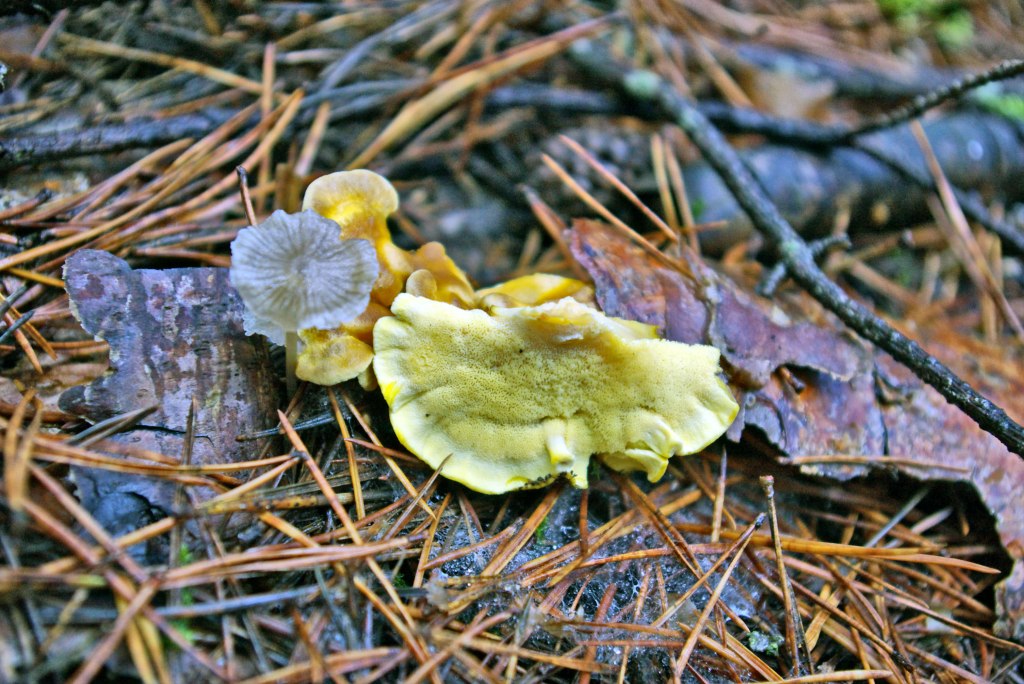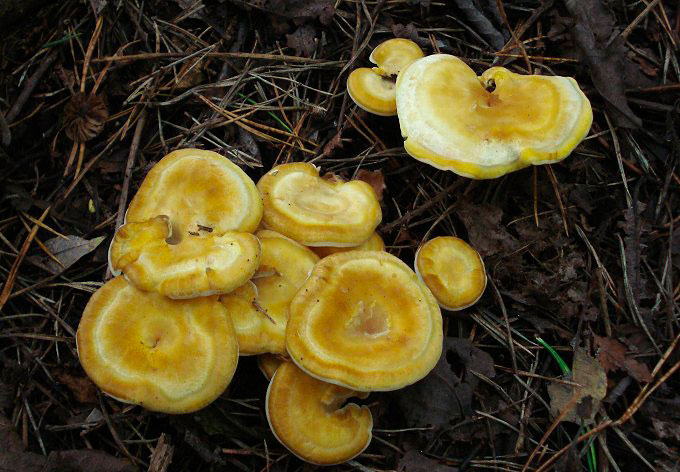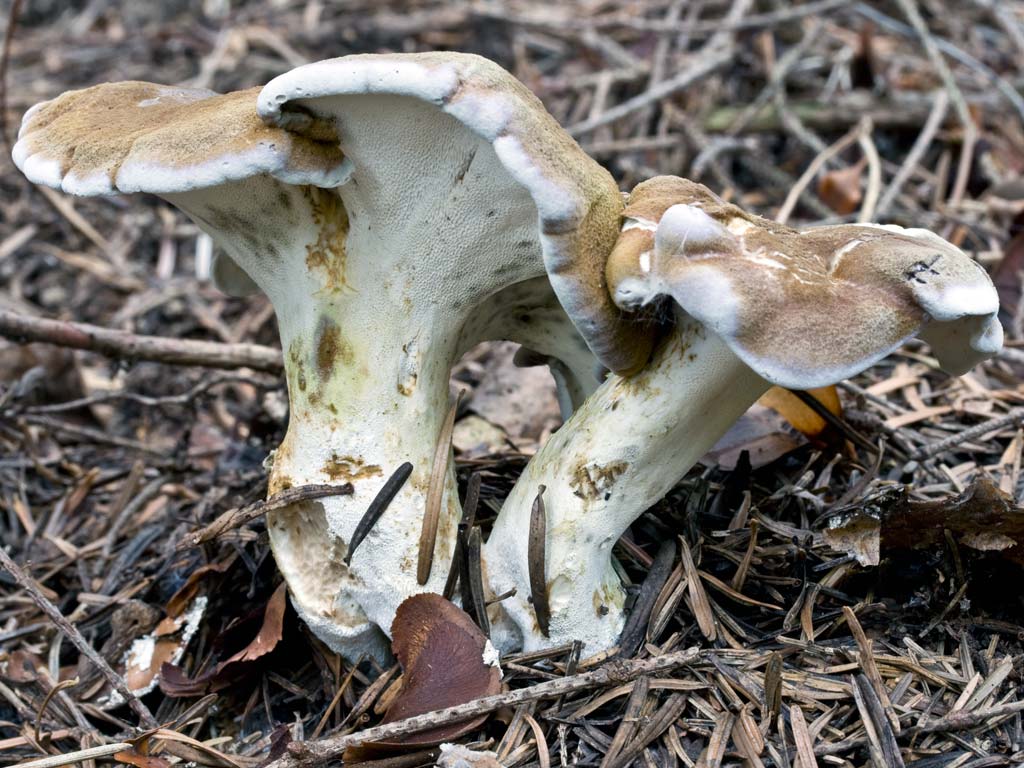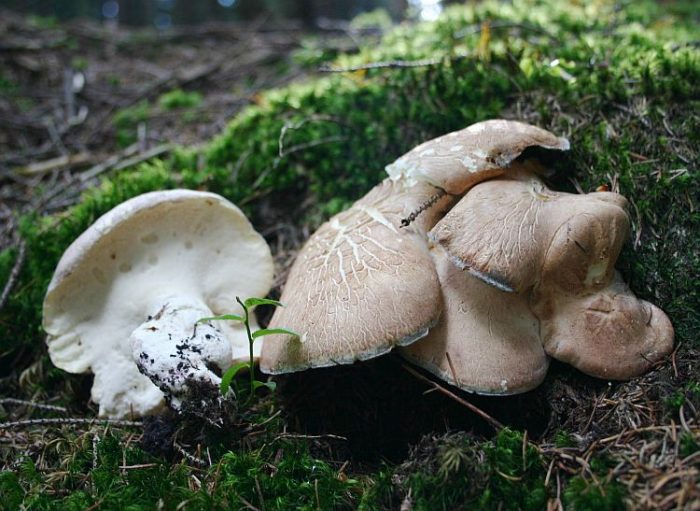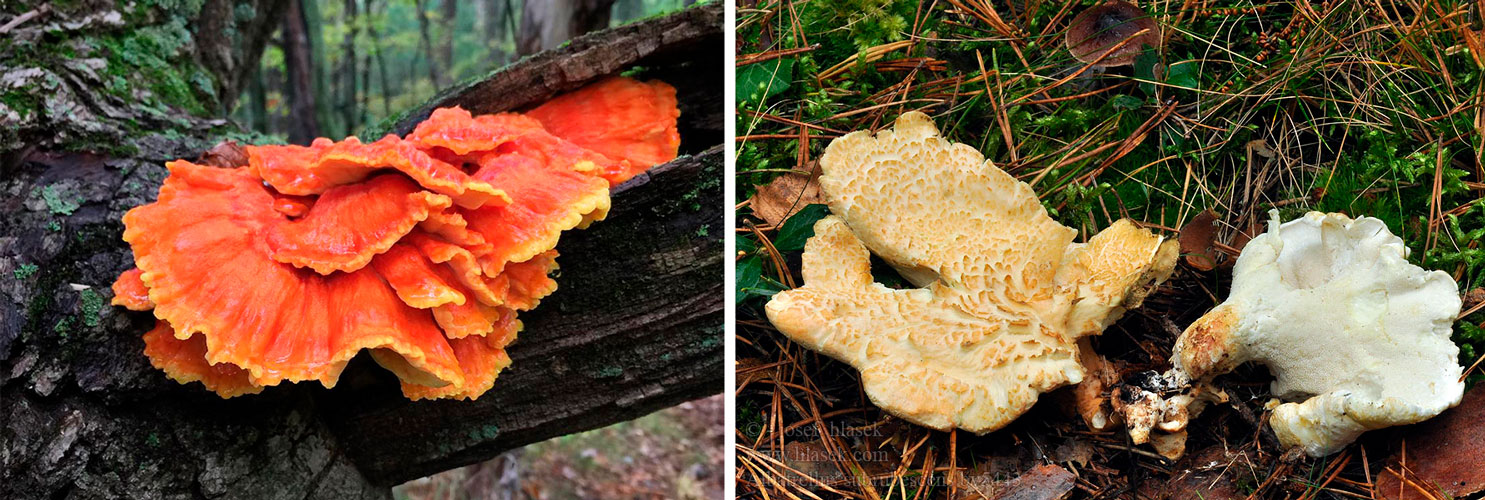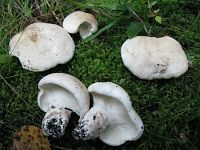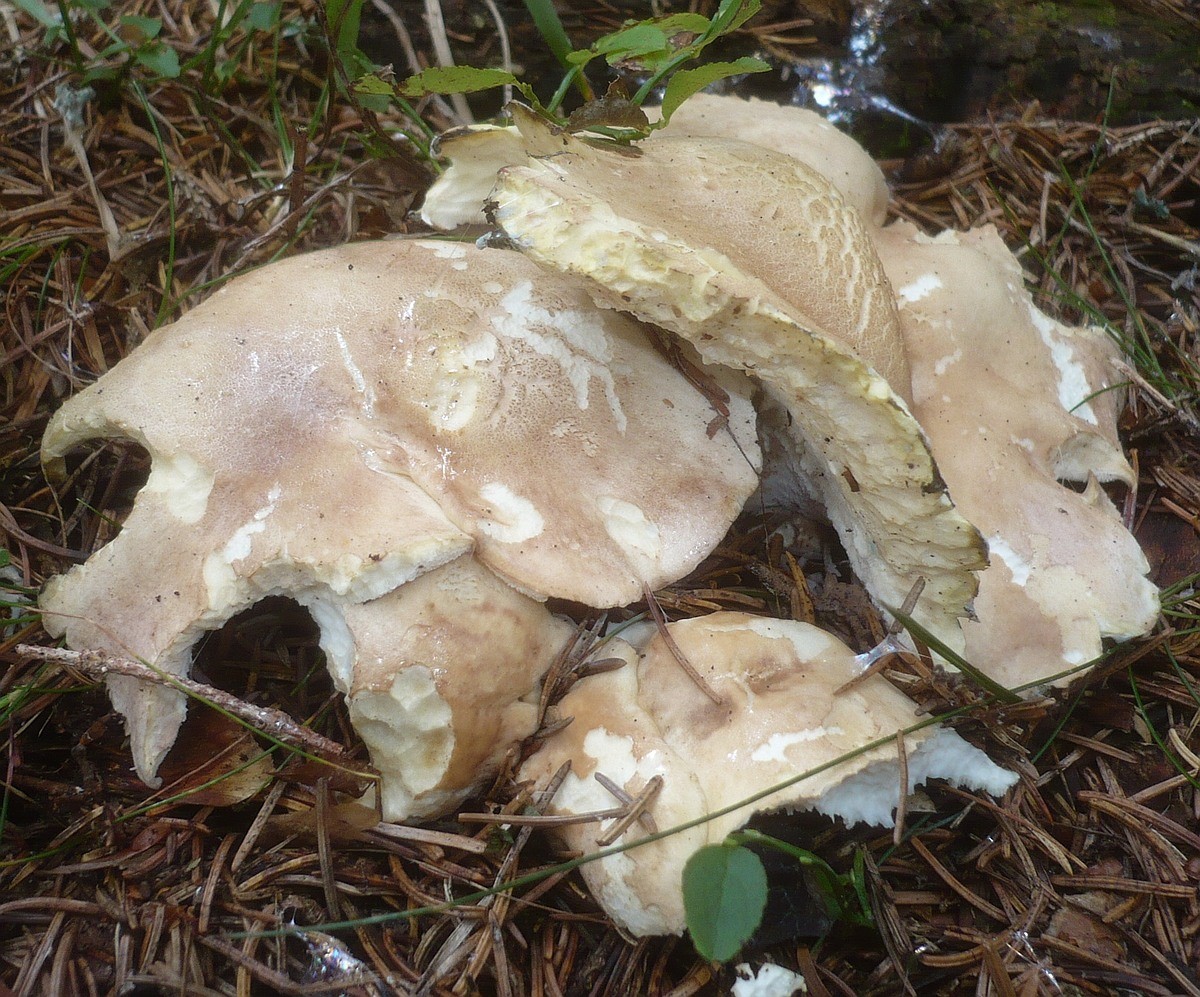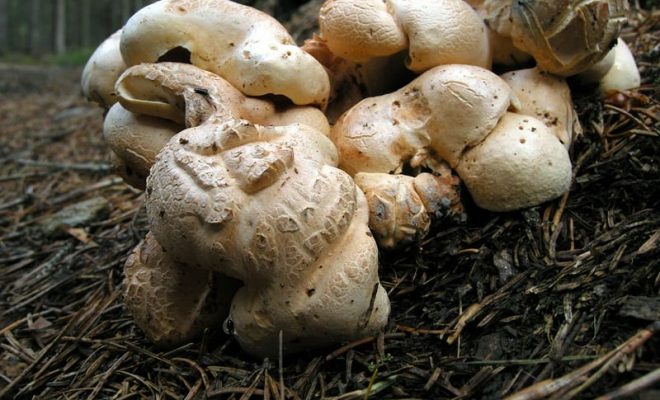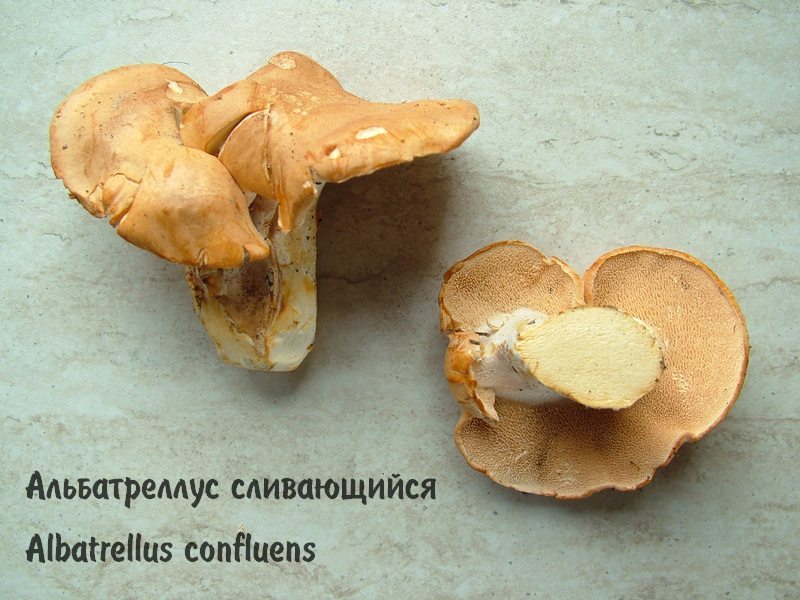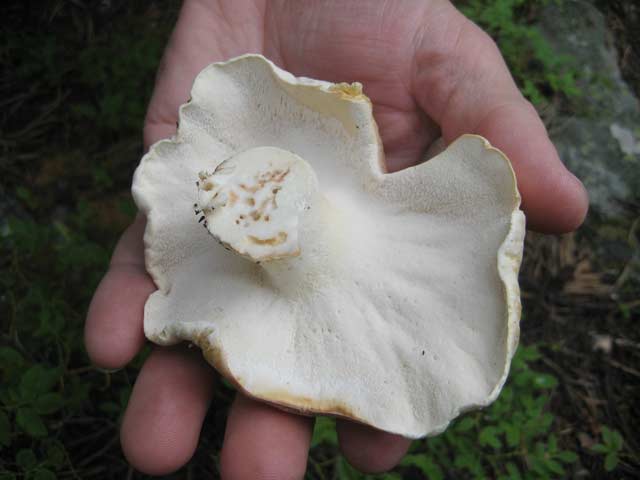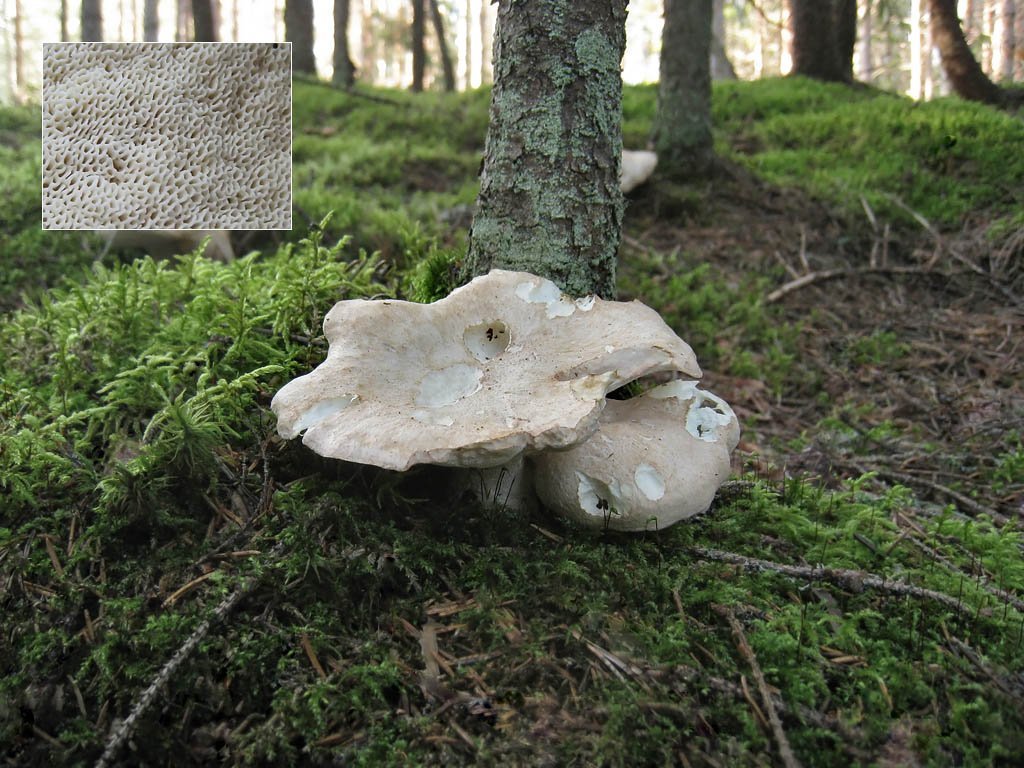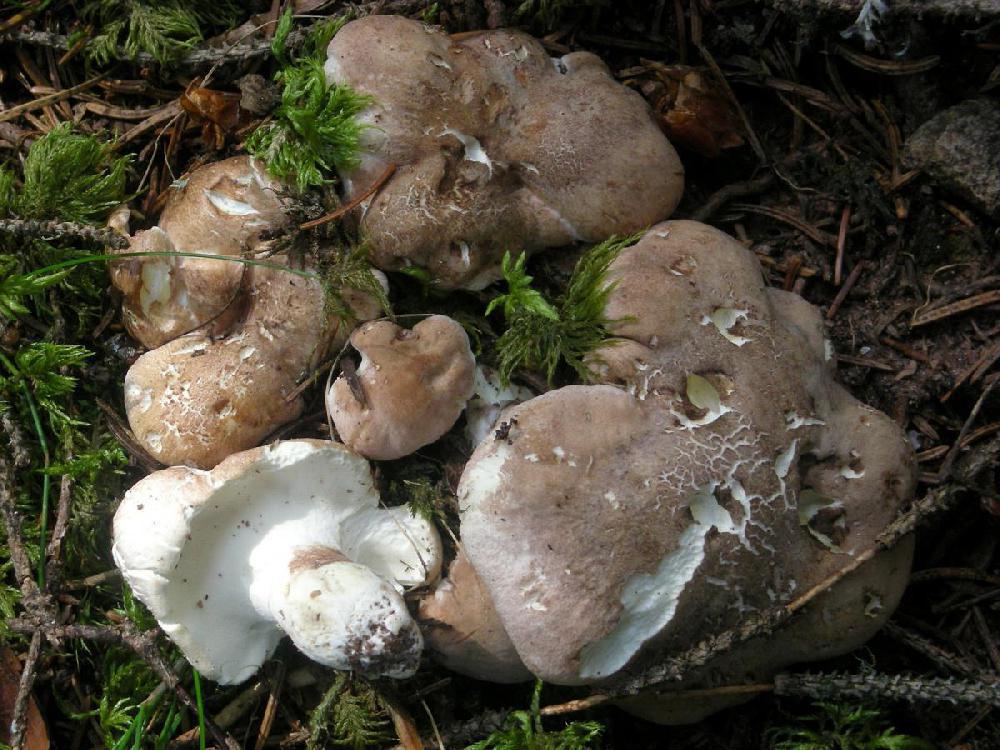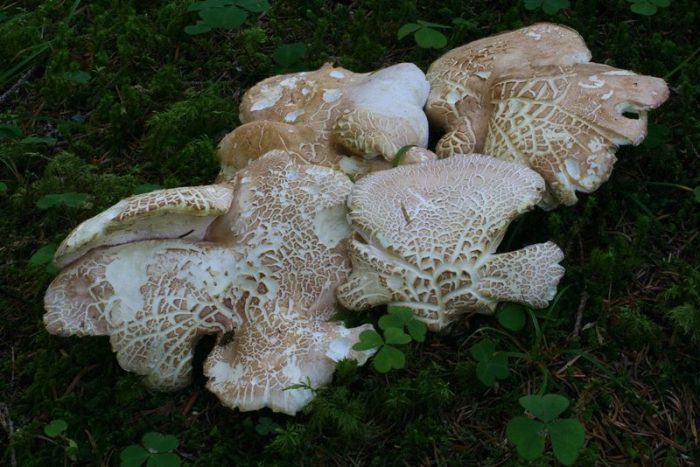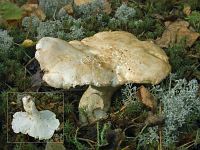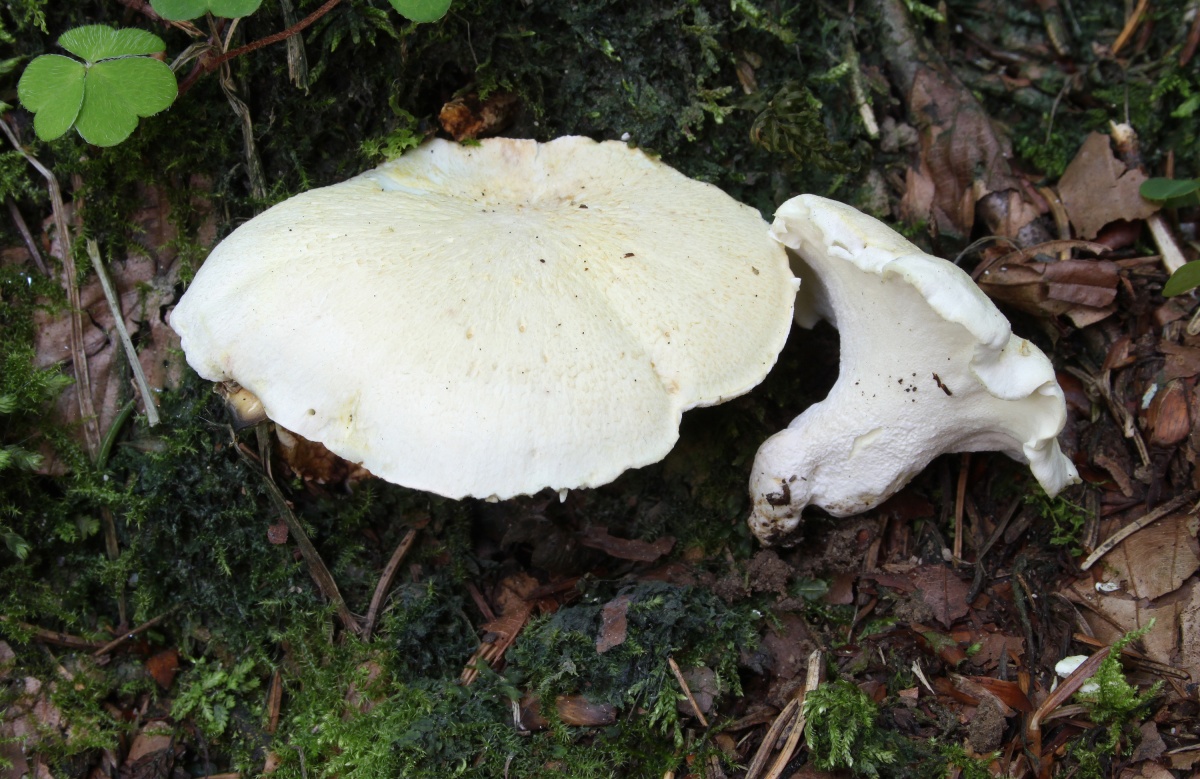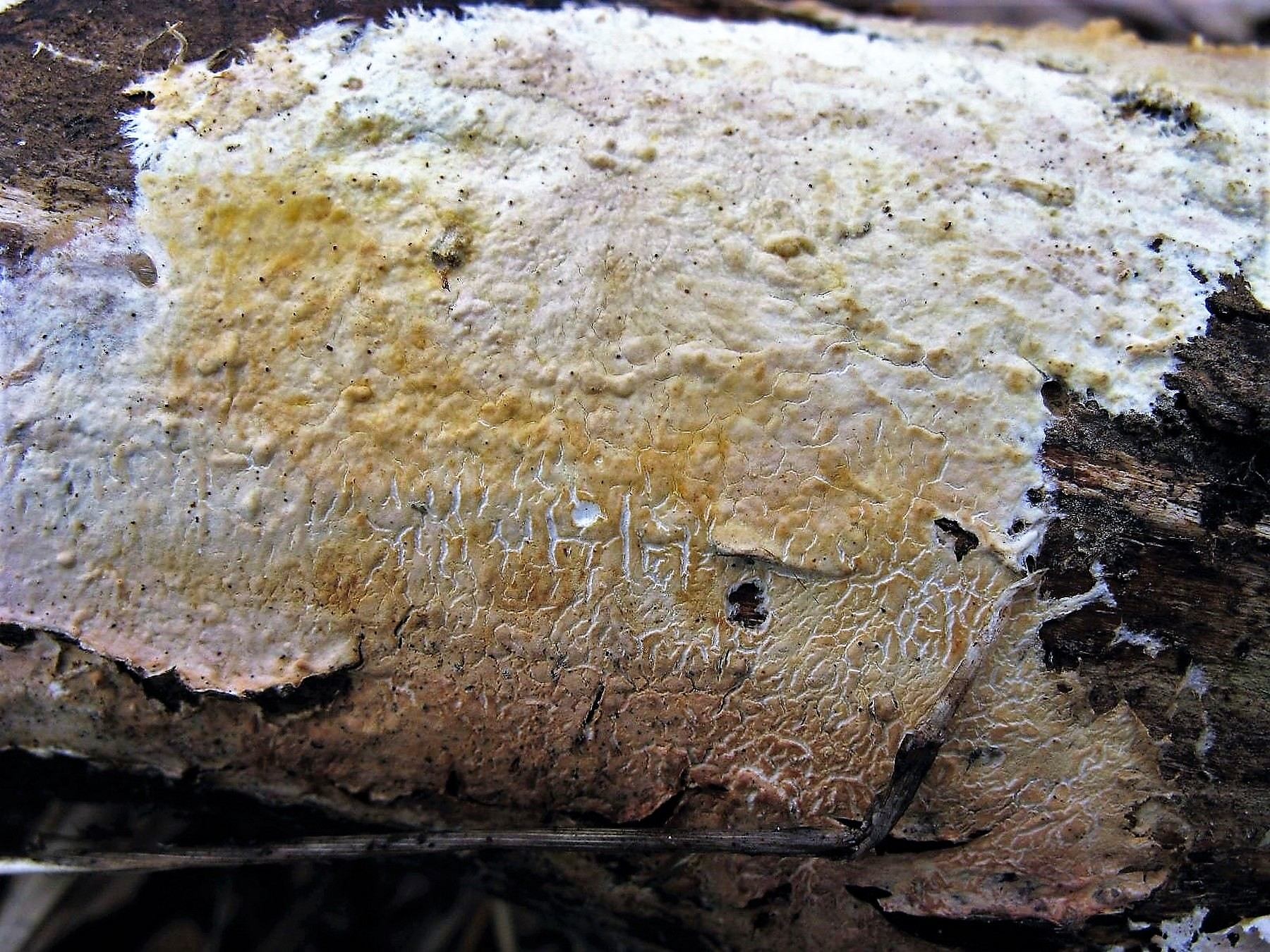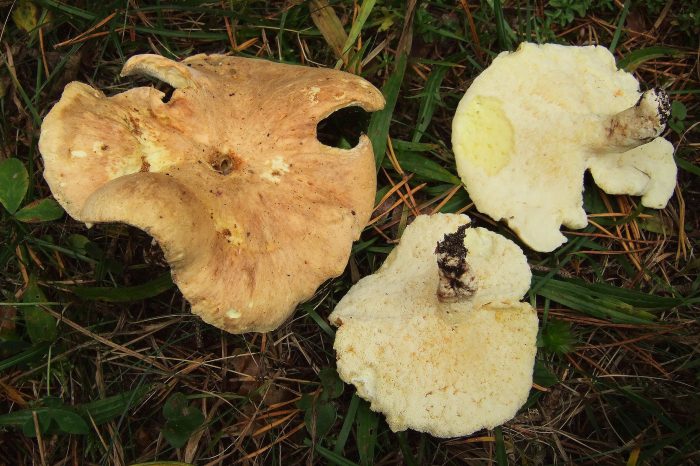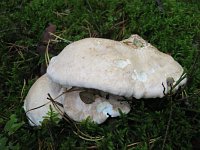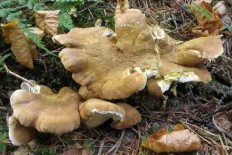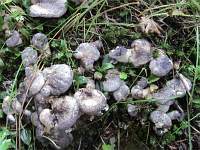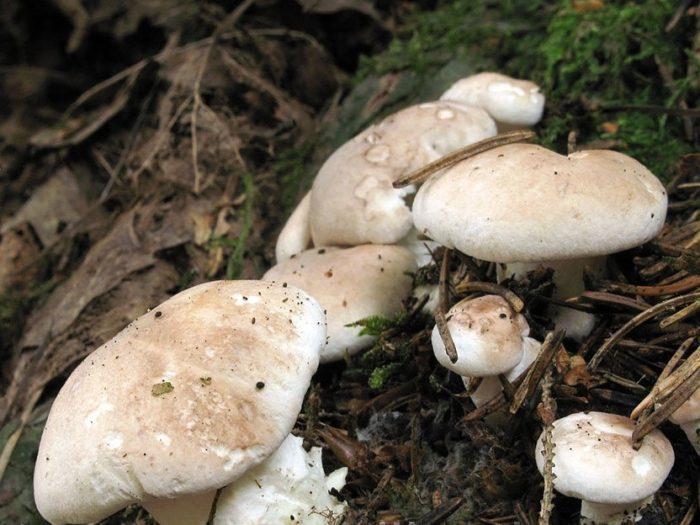Synonyms
- Albatrellopsis confluens (Alb. & Schwein.) Teixeira, 1993
- Boletus artemidorus Lenz, 1830
- Boletus aurantius Schaeff., 1774
- Boletus confluens Alb. & Schwein., 1805: Fr., 1821 basionym non Boletus confluens Schumach., 1803, q. e. Coltricia perennis (L.: Fr.) Murrill, 1903
- Boletus nitens J.F. Gmel., 1792
- Caloporus confluens (Alb. & Schwein.) Quél., 1888
- Caloporus politus (Fr.) Quél., 1886
- Cladomeris confluens (Alb. & Schwein.) Quél., 1886
- Merisma confluens (Alb. & Schwein.) Gillet, 1878
- Polypilus confluens (Alb. & Schwein.) P. Karst., 1881
- Polyporus artemidorus (Lenz) Fr., 1838
- Polyporus confluens (Alb. & Schwein.) Fr., 1821
- Polyporus laeticolor (Murrill) Sacc. & D. Sacc., 1905
- Polyporus pachypus Pers., 1825
- Polyporus politus Fr., 1836
- Polyporus whiteae (Murrill) Sacc. & D. Sacc., 1905
- Scutiger confluens (Alb. & Schwein.) Bondartsev & Singer, 1941
- Scutiger confluens f. politus (Fr.) Bondartsev, 1953
- Scutiger laeticolor Murrill, 1903
- Scutiger whiteae Murrill, 1903
Albatrellus confluent (Albatrellus fused): photo and description, edibility
T. V. Svetlova, I. V. Zmitrovich
1.7.2. Mushrooms of the genus Albatrellus
Mushrooms of the genus Albatrellus (Albatrellus) form fleshy, elastic, dense in consistency fruiting bodies in the form of a cap and a central or eccentric stem, with a porous hymenophore that creeps down to the stem. Most species grow on soil, some on wood. In this subsection below, we provide information about the species that were found by us and our colleagues from Kazakhstan. In addition to these species, several more are known on the territory of Russia: A. caeruleoporus (albatrellus cinepore) - with small bluish-bluish fruiting bodies and a bluish surface of the hymenophore, is known in the Far East; A. cristatus (albatrellus comb) - with olive-brown, yellowish-greenish caps with an eccentric or lateral leg, growing mainly in oak and beech forests; A. pes-caprae (syn. Scutiger pes-caprae, albatrellus goat-footed) - with brownish fruiting bodies with an eccentric or lateral leg, found mainly in coniferous subalpine forests, noted in Ukraine and the Far East; A. subrubescens (blushing albatrellus) - close to the more famous species A. ovinus, differing from it by the formation of reddish spots at the sites of damage and preferring pine forests; A. tianschanicus (Tien Shan albatrellus) is a rare species known from Kyrgyzstan with yellowish scaly caps.
Albatrellus ovinus - sheep tinder fungus
Sheep polypore is a relatively large mushroom with thick, squat fruiting bodies, with a porous hymenophore; it usually grows in large groups in coniferous forests on a moss mat. Young mushrooms are yellowish-white; as they grow, they acquire a grayish-yellowish or brown hue.
Cooking recommendations
Delicious soups are made from dried mushrooms. Fruit bodies can even be eaten raw. They make delicious fried, stewed and first courses.
How to clean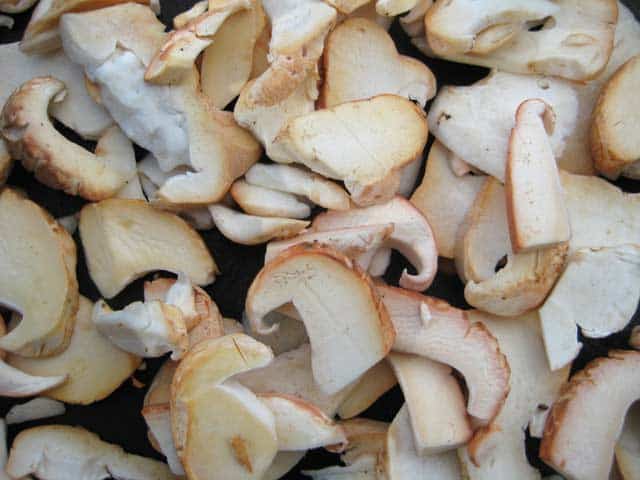
Albatrellus merging does not need cleaning. If you need to free the pulp of the mushroom from the top skin, you can scrape it off with a knife.
How to dry
Tinder fungus is suitable for harvesting for the winter. Mushrooms are washed, peeled and strung on a thread. In good weather they can be dried outside, but they tend to absorb moisture, so the drying process must be controlled. If the mushrooms are saturated with water, they can become moldy and unusable.
In bad weather, albatrellus can be dried in the oven or oven. But you need to try not to overdry, otherwise they may lose their taste. Store the finished product in a dark place, in hermetically sealed glass jars.
How to pickle
Glass or enamel containers are suitable for pickling. The procurement process is simple:
- The mushrooms should be peeled, transferred to a saucepan and boiled for 30 minutes.
- Add salt to the broth (for 1 kg of fruit bodies, 50 g of salt will be required).
- Add bay leaves, garlic and allspice to taste.
- Mix well and put under oppression.
After 7-10 days, the tinder fungus will be ready to eat. Store in a cool place.
Soup recipe
To prepare the first course, you will need the following ingredients:
- mushrooms - 1 kg;
- onion - 2 medium heads;
- carrots - 1-2 pcs.;
- groats (buckwheat, rice, millet) - 300-350 g;
- vegetable oil;
- greens.
Step by step cooking
- Before cooking, you need to wash the tinder fungus, remove the legs and cut into pieces.
- You need to cook the broth for at least twenty minutes, after which you should add fried onions, grated carrots and cereals to it.
- Add herbs and seasonings if desired.
- The soup should be boiled for 10-15 minutes.
Synonyms
- Albatrellopsis confluens (Alb. & Schwein.) Teixeira, 1993
- Boletus artemidorus Lenz, 1830
- Boletus aurantius Schaeff., 1774
- Boletus confluens Alb. & Schwein., 1805: Fr., 1821 basionym non Boletus confluens Schumach., 1803, q. e. Coltricia perennis (L.: Fr.) Murrill, 1903
- Boletus nitens J.F. Gmel., 1792
- Caloporus confluens (Alb. & Schwein.) Quél., 1888
- Caloporus politus (Fr.) Quél., 1886
- Cladomeris confluens (Alb. & Schwein.) Quél., 1886
- Merisma confluens (Alb. & Schwein.) Gillet, 1878
- Polypilus confluens (Alb. & Schwein.) P. Karst., 1881
- Polyporus artemidorus (Lenz) Fr., 1838
- Polyporus confluens (Alb. & Schwein.) Fr., 1821
- Polyporus laeticolor (Murrill) Sacc. & D. Sacc., 1905
- Polyporus pachypus Pers., 1825
- Polyporus politus Fr., 1836
- Polyporus whiteae (Murrill) Sacc. & D. Sacc., 1905
- Scutiger confluens (Alb. & Schwein.) Bondartsev & Singer, 1941
- Scutiger confluens f. politus (Fr.) Bondartsev, 1953
- Scutiger laeticolor Murrill, 1903
- Scutiger whiteae Murrill, 1903
Albatrellus lilac Albatrellus syringae
Syn: Scutiger syringae Parmasto, 1962 Xanthoporus syringae (Parmasto) Audet, 2010

Description by Andrey Yakimenko and Tatiana Svetlova.
Click on the marker to get additional information about the find of this species If you still know the place of growth of this species, please determine its coordinates and send them to the site
Basic information Additional Section-3
On off. mushroom find map
| Full scientific name of this species: Albatrellus syringae (Parmasto) Pouzar, 1966 |
This species belongs to tinder fungi, despite the fact that it lives on the soil and has fruiting bodies with a cap and a leg. The hats are yellow and usually have a few darker areas; legs narrowed towards the base, with mycelial cords. Fruiting bodies very often grow together with the legs and edges of the caps in several copies. It grows near the trunks and stumps of lilacs and some other hardwoods. Rare view. (Tatiana Svetlova)
Common names
FI: Keltakääpä (Finland) DE: Wiesen-Porling; Gezonter Porling (Germany) DK: Gul Fåreporesvamp (Denmark)
Sporecap fruiting body
Fruiting bodies are annual, consisting of a cap and a leg, single or accrete, 2-4 specimens. Caps 3 - 12 cm in diameter up to 1 cm thick, with a thinner, sharp wavy or lobed edge, rounded, kidney-shaped, funnel-shaped, sometimes convex in the center. The surface is glabrous or slightly pubescent, yellow-cream, ocher-yellow, clearly or indistinctly zoned, with darker zones, often egg-yellow along the edge, brownish in old age.
Hymenophore Hymenophore
Tubules descending along the stem, up to 3 mm long, thick-walled. The surface of the hymenophore is pale lemon, yellow-cream, later dirty yellow with a whitish bloom. The pores are rounded, angular, sometimes with ciliate margins, 3-4 (5) per 1 mm.
Micromorphology Micromorphology
The hyphalous system is monomytic. The hyphae of the tissue of the cap and legs are densely woven, hyaline, branching, sinuous, thin-walled, with a varying diameter from 3 to 15 microns, in swellings up to 25 microns in diameter, with small buckles. The hyphae of the tubules are parallel tightly woven, often with granular contents, 2-5 µm in diameter. Basidia are clavate, with a buckle at the base, 15–25 x 5–7 µm, with 4 sterigmas 2–4 µm in length. Spores are broadly ellipsoidal, flattened on one side, hyaline, with a large droplet, 3.5 - 5 x 2.5 - 3.5 µm.
Stem leg
The leg is densely fleshy, brittle, somewhat fibrous, often central, 1 - 7 cm long, 1 - 2 cm in diameter, tapering towards the base, with mycelial cords. The color is cream, ocher yellow. In old fruiting bodies, the stem may be hollow.
Flesh pulp
The tissue of the cap is fleshy, slightly fibrous, zoned, whitish or dark creamy with a pleasant nutty flavor; dry hard and brittle.
Habitat habitat
Grows on soil in parks, forests, near the trunks or stumps of lilac, willow, linden, alder.
Distribution of Areal
The species is common in Europe, Asia, North America. On the territory of Russia, it was noted in the European part (Moscow region), Western Siberia (Yamalo-Nenets Autonomous Okrug), Irkutsk region, in the Far East.
Calendar Calendar
It grows from spring to late autumn.
Edibility Edibility
Edible.
Remarks
The species is included in the Red Lists of the following European countries: Estonia (CR), Norway (LC). It is not listed in the Red Data Books of the constituent entities of the Russian Federation, as well as the Red Data Book of Russia. Note: in brackets is the status that characterizes the degree of rarity of the described species in a given country.
Taxon authors: Parmasto - Parmasto, Erast (1928-), Estonian botanist and mycologist - described this species as Scutiger syringae; Pouzar - Pouzar, Zdenek (1932-), Czech mycologist.
The use of curly griffins
The use of curly griffins has been known for a long time. Firstly, this mushroom is prized for its excellent immunostimulating effects. Secondly, in terms of the number of useful components, this specimen is extremely valuable. Thirdly, maitake is able to provide significant support to the cardiovascular system. And the composition of this mushroom includes substances that have a caring effect on the walls of blood vessels, cleanse the blood of cholesterol and normalize blood flow in general.
On the basis of this substance, a lot of medicines with a bactericidal effect are prepared. In addition, for a long time, medicines and decoctions for tuberculosis have been prepared from mushroom powder. With regular use of curly griffin it helps to improve the functioning of the nervous system, fights against severe headaches, saves from chronic fatigue and chronic overwork.
Grifola is able to have a beneficial effect in the treatment of problems in the oncological field. It is an excellent additional agent that neutralizes the side effects of chemotherapy and prevents the formation of metastases. And also this product is an excellent cancer prevention.
The maitake mushroom has proven itself perfectly in cleansing organisms from toxins and toxins. It has a positive effect on the condition of the skin:
- restores elasticity and firmness;
- removes greasy shine;
- cleanses pores;
- evens out the tone.
The use of sheep albatrellus in cooking
Sheep tinder fungus is an edible mushroom belonging to the fourth category. It is not very popular with mushroom pickers for two reasons. Firstly, it is not widely used and rather difficult to find. Secondly, it is advisable to eat only young mushrooms. A mature plant acquires excessive rigidity, which is not removed even after prolonged heat treatment. Sheep mushroom can be consumed in any form: boiled, fried, stewed.
How to dry a mushroom
These mushrooms are great for drying. You can dry them in different ways: in the sun, in an oven, in an oven or on a gas stove. Mushrooms are dried outdoors only in sunny, dry weather, otherwise they may deteriorate. Mushrooms must be fresh, healthy, not damaged by worms. They need to be cleaned, wiped with a clean, damp cloth and sized. Mushrooms cannot be washed, they easily absorb water and do not dry well. It is best to use special tools for drying. You can make your own sieves, meshes, grids. You can string mushrooms on a thread or special hairpins. Since mushrooms dry unevenly, you need to constantly monitor the process. An overdried mushroom loses its taste, and an underdried one will quickly grow moldy and deteriorate. Ready tinder fungus is dry, light, close to fresh in taste and aroma. They should be stored in dry ventilated areas, packed in sealed metal or glass jars. It is not recommended to keep dried mushrooms in fabric bags, as they easily absorb moisture and foreign odors.
How to pickle sheep tinder
Other ways of storing sheep tinder fungus are salting and pickling. Mushrooms are salted in glass, enamel or wooden dishes. Peeled and washed mushrooms should be boiled in lightly salted water for about half an hour. Then drain the water, and discard the mushrooms in a colander. Next, put them in a container for pickling and add salt at the rate of 50-60 grams for each kilogram of mushrooms. You can add garlic, pepper, bay leaf. We put under oppression. And after a week you can have a delicious dish. Store such mushrooms in a cool room. Make sure that the brine completely covers the mushrooms.
Albatrellus soup
Albatrellus can be used to make a delicious soup. To do this, you need to take a kilogram of fresh mushrooms, sort them out, peel them, remove the legs, and wash them thoroughly. Fill the medium-sized chopped mushrooms with water and cook for about 15–20 minutes. Saute four heads of onions in vegetable oil. Add 350 grams of any cereal, fried onions, herbs, seasonings to taste to boiled mushrooms and bring to readiness.
Second courses and salads
Tinder mushrooms add special sophistication to main courses and salads. Try mushroom rolls. To do this, boil fresh mushrooms and then fry until tender.Next, grind them into minced meat, adding onion, garlic, salt, pepper. Put finely chopped boiled eggs and mayonnaise in the resulting minced meat. From the resulting mixture we form small sausages and wrap them in slices of ham. We spread the rolls on a deep dish, decorate as you wish and fill with meat jelly. The cooled dish is ready to eat.
Pickled mushrooms are also widely used in the kitchen. They can be used to make delicious salads. Here is a recipe for one of them. Chop a kilogram of salted or pickled mushrooms, add finely chopped green onions to them. Mix the mushrooms with diced boiled potatoes (300 grams) and a jar of green peas. Mayonnaise is used as a dressing for this salad; add salt and pepper to taste.
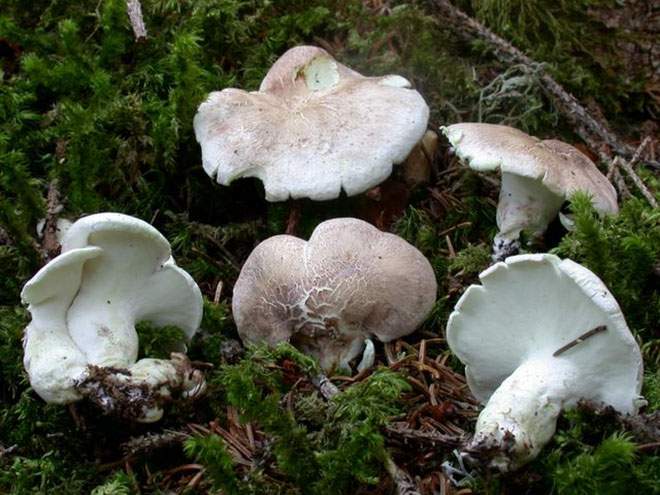
Albatrellus sheep (sheep tinder fungus, sheep mushroom)
Healing properties
Sheep tinder fungi contain all essential vitamins and minerals, as well as amino acids, organic acids, fiber, antibiotic and immunomodulating substances. Therefore, with regular use, albatrellus:
- works as a natural anti-inflammatory and prevents the development of infections;
- reduces pain in chronic and acute diseases;
- increases the body's immunity due to the significant content of vitamin C and folic acid;
- has a beneficial effect on the skeletal system and strengthens blood vessels;
- helps to normalize digestion.
Eating fruiting bodies is useful in case of a tendency to anemia, sheep tinder contains a lot of proteins, therefore, it helps to quickly gain muscle mass and improves blood composition.
The use of sheep mushroom in traditional medicine
Sheep tinder is often found in home health recipes. On its basis, decoctions and water infusions, alcoholic tinctures and dry powders are prepared.
The substance griffolin in the composition of the fungus has a special value; it inhibits the growth of malignant cells and helps prevent cancer.
Sheep tinder fungus is also used to relieve inflammation in colds, infections and joint ailments - neogrypholine in its composition helps to fight negative processes.
Polypore contains the substance scutigeral, it is considered an effective pain reliever and can be used to relieve discomfort with a wide variety of ailments.
Advice! It is possible to use tinder fungus for treatment as part of medicinal tinctures and decoctions, but simple use of the mushroom in food also brings benefits in diseases.
The main thing is that the sheep albatrellus is present on the table on a regular basis.

Eating Sheep Tinder is Good for Your Health
Synonyms
- Albatrellopsis confluens (Alb. & Schwein.) Teixeira, 1993
- Boletus artemidorus Lenz, 1830
- Boletus aurantius Schaeff., 1774
- Boletus confluens Alb. & Schwein., 1805: Fr., 1821 basionym non Boletus confluens Schumach., 1803, q. e. Coltricia perennis (L.: Fr.) Murrill, 1903
- Boletus nitens J.F. Gmel., 1792
- Caloporus confluens (Alb. & Schwein.) Quél., 1888
- Caloporus politus (Fr.) Quél., 1886
- Cladomeris confluens (Alb. & Schwein.) Quél., 1886
- Merisma confluens (Alb. & Schwein.) Gillet, 1878
- Polypilus confluens (Alb. & Schwein.) P. Karst., 1881
- Polyporus artemidorus (Lenz) Fr., 1838
- Polyporus confluens (Alb. & Schwein.) Fr., 1821
- Polyporus laeticolor (Murrill) Sacc. & D. Sacc., 1905
- Polyporus pachypus Pers., 1825
- Polyporus politus Fr., 1836
- Polyporus whiteae (Murrill) Sacc. & D. Sacc., 1905
- Scutiger confluens (Alb. & Schwein.) Bondartsev & Singer, 1941
- Scutiger confluens f. politus (Fr.) Bondartsev, 1953
- Scutiger laeticolor Murrill, 1903
- Scutiger whiteae Murrill, 1903

